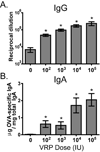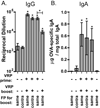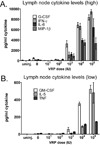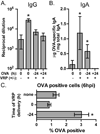Alphavirus replicon-based enhancement of mucosal and systemic immunity is linked to the innate response generated by primary immunization
- PMID: 20184975
- PMCID: PMC2855431
- DOI: 10.1016/j.vaccine.2010.02.010
Alphavirus replicon-based enhancement of mucosal and systemic immunity is linked to the innate response generated by primary immunization
Abstract
Venezuelan equine encephalitis virus replicon particles (VRP) function as an effective systemic, cellular and mucosal adjuvant when codelivered with antigen, and show promise for use as a component in new and existing human vaccine formulations. We show here that VRP are effective at low dose and by intramuscular delivery, two useful features for implementation of VRP as a vaccine adjuvant. In mice receiving a prime and boost with antigen, we found that VRP are required in prime only to produce a full adjuvant effect. This outcome indicates that the events triggered during prime with VRP are sufficient to establish the nature and magnitude of the immune response to a second exposure to antigen. Events induced by VRP in the draining lymph node after prime include robust secretion of many inflammatory cytokines, upregulation of CD69 on leukocytes, and increased cellularity, with a disproportionate increase of a cell population expressing CD11c, CD11b, and F4/80. We show that antigen delivered 24h after administration of VRP does not benefit from an adjuvant effect, indicating that the events which are critical to VRP-mediated adjuvant activity occur within the first 24h. Further studies of the events induced by VRP will help elucidate the mechanism of VRP adjuvant activity and will advance the safe implementation of this adjuvant in human vaccines.
Copyright 2010 Elsevier Ltd. All rights reserved.
Figures







Similar articles
-
Infected dendritic cells are sufficient to mediate the adjuvant activity generated by Venezuelan equine encephalitis virus replicon particles.Vaccine. 2012 Jun 22;30(30):4532-42. doi: 10.1016/j.vaccine.2012.04.030. Epub 2012 Apr 21. Vaccine. 2012. PMID: 22531556 Free PMC article.
-
Alphavirus replicon particles acting as adjuvants promote CD8+ T cell responses to co-delivered antigen.Vaccine. 2008 Aug 5;26(33):4267-75. doi: 10.1016/j.vaccine.2008.05.046. Epub 2008 Jun 9. Vaccine. 2008. PMID: 18582997 Free PMC article.
-
The contribution of type I interferon signaling to immunity induced by alphavirus replicon vaccines.Vaccine. 2008 Sep 15;26(39):4998-5003. doi: 10.1016/j.vaccine.2008.07.011. Epub 2008 Jul 24. Vaccine. 2008. PMID: 18656518 Free PMC article.
-
Mucosal and systemic adjuvant activity of alphavirus replicon particles.Proc Natl Acad Sci U S A. 2006 Mar 7;103(10):3722-7. doi: 10.1073/pnas.0600287103. Epub 2006 Feb 27. Proc Natl Acad Sci U S A. 2006. PMID: 16505353 Free PMC article.
-
Alphavirus replicon particles as candidate HIV vaccines.IUBMB Life. 2002 Apr-May;53(4-5):209-11. doi: 10.1080/15216540212657. IUBMB Life. 2002. PMID: 12120997 Review.
Cited by
-
Prime-boost approaches to tuberculosis vaccine development.Expert Rev Vaccines. 2012 Oct;11(10):1221-33. doi: 10.1586/erv.12.94. Expert Rev Vaccines. 2012. PMID: 23176655 Free PMC article. Review.
-
Alphavirus Replicon Particle Vaccine Breaks B Cell Tolerance and Rapidly Induces IgG to Murine Hematolymphoid Tumor Associated Antigens.Front Immunol. 2022 May 24;13:865486. doi: 10.3389/fimmu.2022.865486. eCollection 2022. Front Immunol. 2022. PMID: 35686131 Free PMC article.
-
Antigen sparing with adjuvanted inactivated polio vaccine based on Sabin strains.Vaccine. 2013 Feb 18;31(9):1298-304. doi: 10.1016/j.vaccine.2012.12.076. Epub 2013 Jan 9. Vaccine. 2013. PMID: 23313617 Free PMC article.
-
Progress in respiratory virus vaccine development.Semin Respir Crit Care Med. 2011 Aug;32(4):527-40. doi: 10.1055/s-0031-1283289. Epub 2011 Aug 19. Semin Respir Crit Care Med. 2011. PMID: 21858754 Free PMC article. Review.
-
A Critical Review about Different Vaccines against Classical Swine Fever Virus and Their Repercussions in Endemic Regions.Vaccines (Basel). 2021 Feb 15;9(2):154. doi: 10.3390/vaccines9020154. Vaccines (Basel). 2021. PMID: 33671909 Free PMC article. Review.
References
-
- Kwissa M, Kasturi SP, Pulendran B. The science of adjuvants. Expert review of vaccines. 2007 Oct;6(5):673–684. - PubMed
-
- McKee AS, Munks MW, Marrack P. How do adjuvants work? Important considerations for new generation adjuvants. Immunity. 2007 Nov;27(5):687–690. - PubMed
-
- Mestecky J. The common mucosal immune system and current strategies for induction of immune responses in external secretions. J Clin Immunol. 1987 Jul;7(4):265–276. - PubMed
-
- Neutra MR, Kozlowski PA. Mucosal vaccines: the promise and the challenge. Nature reviews. 2006 Feb;6(2):148–158. - PubMed
Publication types
MeSH terms
Substances
Grants and funding
LinkOut - more resources
Full Text Sources
Other Literature Sources
Research Materials

